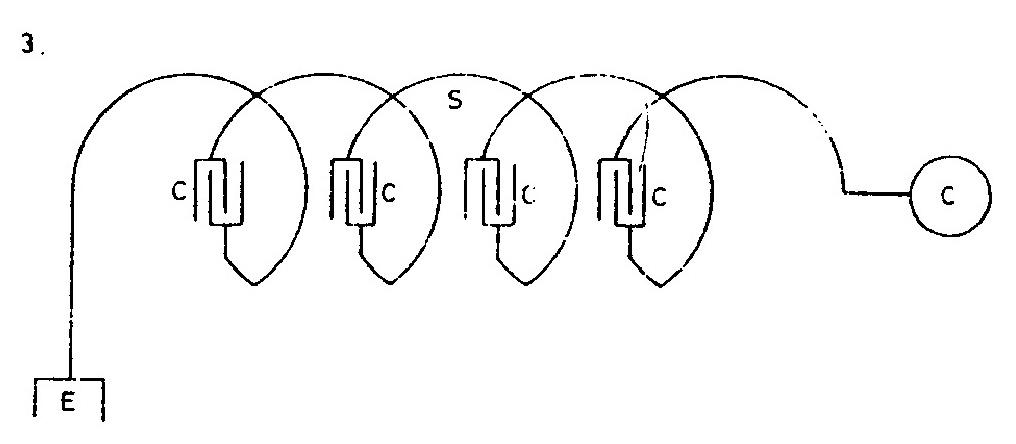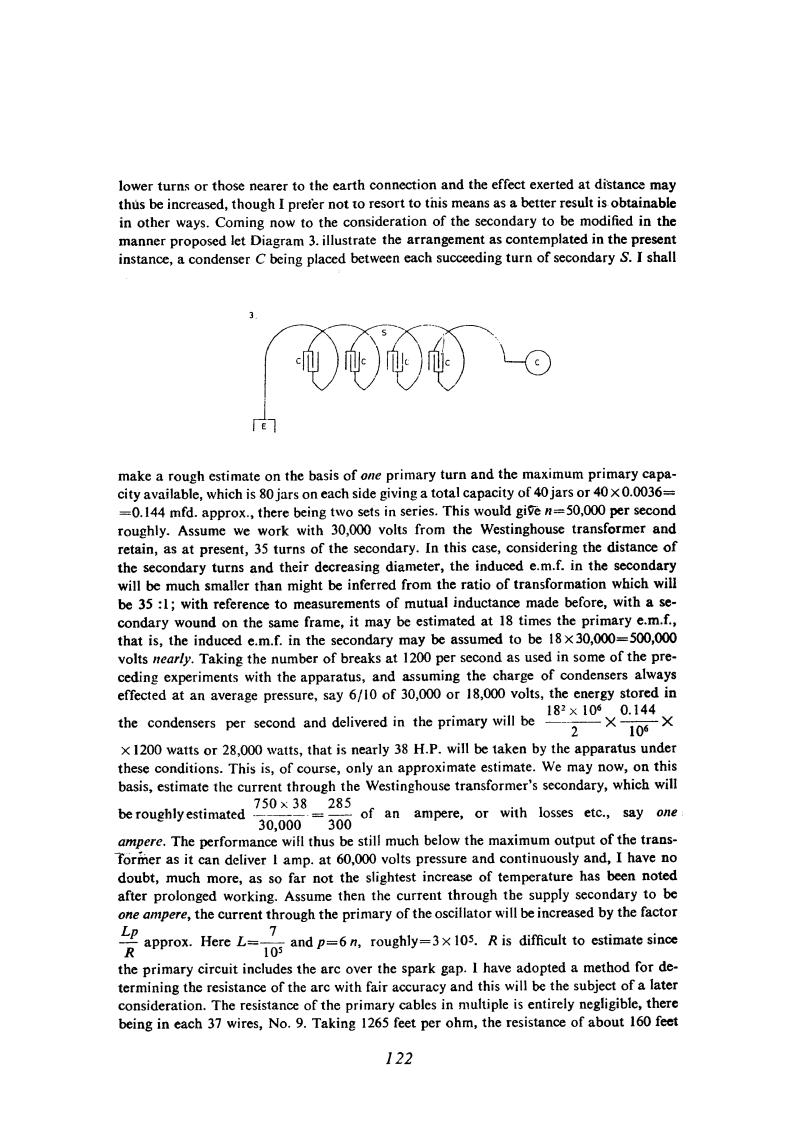
Nikola Tesla Books
lower turns or those nearer to the earth connection and the effect exerted at distance may thus be increased, though I prefer not to resort to this means as a better result is obtainable in other ways. Coming now to the consideration of the secondary to be modified in the manner proposed let Diagram 3. illustrate the arrangement as contemplated in the present instance, a condenser C being placed between each succeeding turn of secondary S. I shall make a rough estimate on the basis of one primary turn and the maximum primary capacity available, which is 80 jars on each side giving a total capacity of 40 jars or 40 x 0.0036 = 0.144 mfd. approx., there being two sets in series.
This would give n = 50,000 per second roughly. Assume we work with 30,000 volts from the Westinghouse transformer and retain, as at present, 35 turns of the secondary. In this case, considering the distance of the secondary turns and their decreasing diameter, the induced e.m.f. in the secondary will be much smaller than might be inferred from the ratio of transformation which will be 35:1; with reference to measurements of mutual inductance made before, with a secondary wound on the same frame, it may be estimated at 18 times the primary e.m.f., that is, the induced e.m.f. in the secondary may be assumed to be 18 x 30,000 = 500,000 volts nearly. Taking the number of breaks at 1200 per second as used in some of the preceding experiments with the apparatus, and assuming the charge of condensers always effected at an average pressure, say 6/10 of 30,000 or 18,000 volts, the energy stored in the condensers per second and delivered in the primary will be $! {{{18^{2} \times 10^{6}} \over 2} \times {0.144 \over 10^{6}} \times 1200} $! watts or 28,000 watts, that is nearly 38 H.P. will be taken by the apparatus under these conditions. This is, of course, only an approximate estimate. We may now, on this basis, estimate the current through the Westinghouse transformer's secondary, which will be roughly estimated $! {{{750 \times 38} \over 30,000} = {285 \over 300}} $! of an ampere, or with losses etc., say one ampere. The performance will thus be still much below the maximum output of the transformer as it can deliver 1 amp. at 60,000 volts pressure and continuously and, I have no doubt, much more, as so far not the slightest increase of temperature has been noted after prolonged working. Assume then the current through the supply secondary to be one ampere, the current through the primary of the oscillator will be increased by the factor $! {Lp \over R} $! approx. Here $! {L = {7 \over 10^{5}}} $! and p = 6n, roughly = 3 x 105. R is difficult to estimate since the primary circuit includes the arc over the spark gap. 1 have adopted a method for determining the resistance of the arc with fair accuracy and this will be the subject of a later consideration. The resistance of the primary cables in multiple is entirely negligible, there being in each 37 wires. No. 9. Taking 1265 feet per ohm, the resistance of about 160 feet
122
July 31
Tesla made the capacitors for primary circuit from mineral water bottles filled with a saturated solid salt solution. He then submerged several bottles in a metal tank filled with the same solution. By that method he obtained the capacitor groups with a common layer. Other layers (electrolyte in jars) could have been connected in parallel as desired. The least capacitance change of capacitor battery of this type amounted to exactly the capacitance of one jar. By performing the withstand tests on such capacitors at a frequency of 144 Hz he concluded that they could withstand even 30,000 volts when two series of them are connected in series. By so solving the capacitor problems in primary circuit, he returns again to the secondary circuit. In the secondary he hadn't yet solved the problem of coil distributed capacitance, in which he sees the main obstacle on the way of achievement of desirable high voltages. Tesla's analysis, somewhat strange for a reader of these days (sometimes even incorrect) as hosed on a limited number of facts, impressed with its breadth. Tesla deeply penetrates in physical processes, and attempts to understand what and how something happens. His experiments provide him with proofs for conclusions he came to on the basis of thinking and analysis of previous experiments.
By having a desire to design the secondary coil with minimal self-capacitance, and which will be able to operate at extraordinary high voltages, Tesla devoted his time, more than anybody else before him, to a study of coils. The results were not lacking (coil shapes, winding methods), but with all that Tesla was not satisfied. He thinks what would happen when he would add series capacitors, and what would happen if he could change the distance between windings, or the wire diameter, etc.


